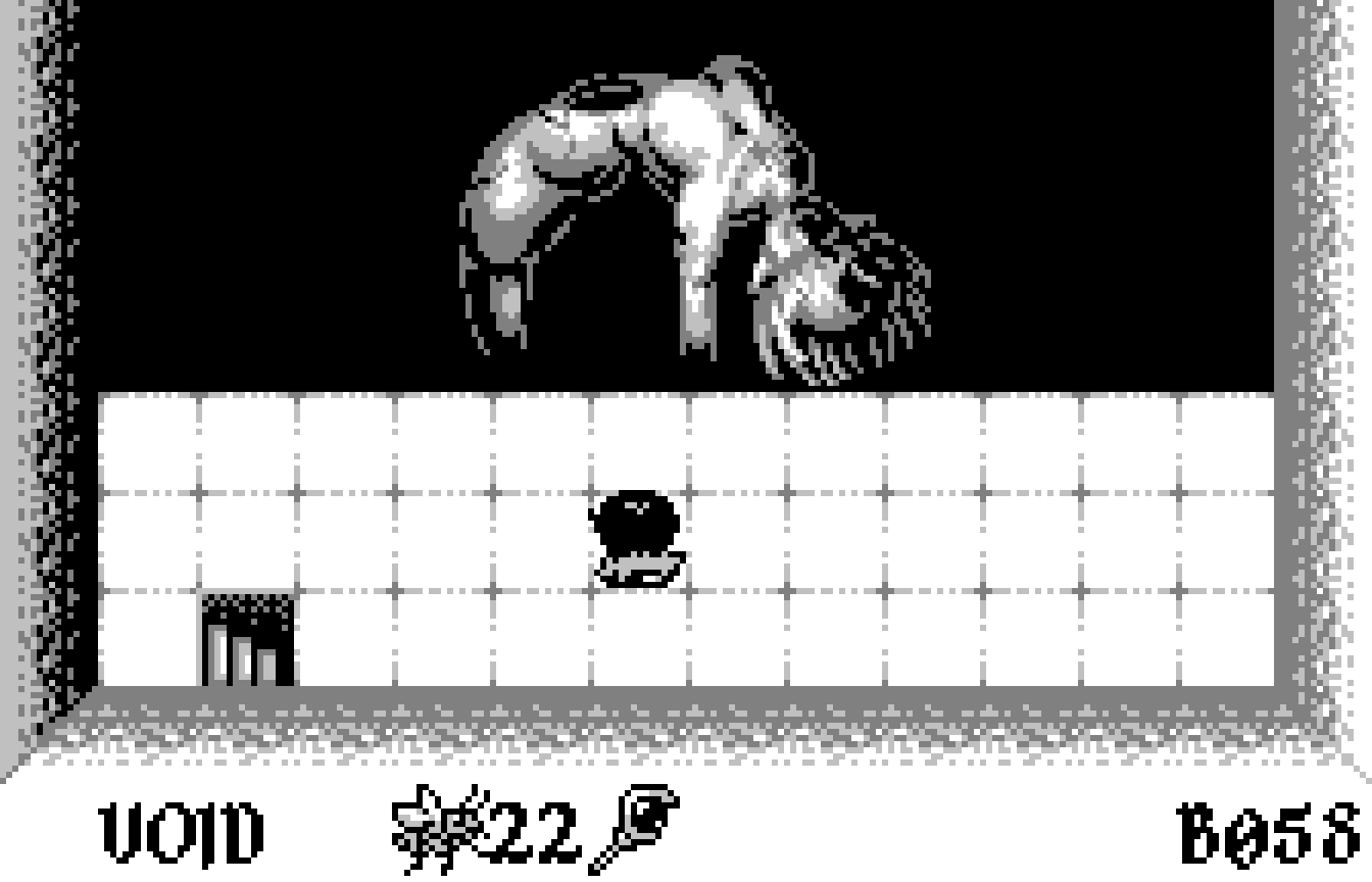Void Stranger is a very interesting game. Coming from System Erasure, the creators of ZeroRanger, this is a sokoban-style puzzle game where the main goal is not to move objects to their destinations, but just to reach the exit.

And if you look at the steam reviews, there will be plenty of people telling you that this game is amazing, and some of them will recommend you to go in blind. They’re not wrong - it’s hard to explain what makes Void Stranger great without spoiling the hell out of it, but, if you want to try it, and you want to stay clean, then I would like to issue a bit of a warning.
Here’s how we’re gonna do this: in the first part of this post I will talk a little bit about certain nuances of the game that I believe you should be aware of, even if you want to start a blind playthrough. After that, you can stop reading and go play the game. In the second part, I will explain what makes this game great (and what doesn’t), but it will include some technical (read: non-story) spoilers.

Part 1: Per aspera…
So, if you want to start Void Stranger, here’s what you should know:
- This game is big. It’s huge. There are many, many different rooms that you’ll have to go through. If you really like puzzle games, then this is the game for you. If you’re more of a casual puzzle game enjoyer, this is going to be quite a commitment. However, to balance this, there’s a bit more to the game than just the puzzles.
- This game has a story. From time to time, after completing a bunch of rooms, you will get a piece of the story, which is a good enough motivation to keep going, and also a perfect point for a break from all the puzzle solving. That said, the story beats are generally short, and the time spent in anticipation for the next one is only going to get longer, as puzzles become harder and harder.
- The puzzles get hard. Do not be afraid to use a guide. And by that I mean, you can find a spoiler-free guide to the puzzle rooms, and use it if you find yourself stuck. The increase in difficulty can make the experience frustrating, and even though the developers mention “frustration” as a part of the feature set, there’s only so much of it you can have before just rage-quitting the game.
- This one is gonna be a bit vague, but, basically, Every Path is Valid. If you feel like you might’ve made a big mistake, don’t panic and keep going - eventually you’ll understand how to make things right. Also, the game autosaves all the time, and it doesn’t have a save system, so be prepared to live with your decisions. At least for some time.
To summarize all of this in simple words: There’s a good chance that you might suffer. And this will split people into two main categories: the ones who gave up early, after realizing that they’re not ready for this level of commitment, and the ones who went into The Void and refused to stop.

One of the most interesting aspects of this game is that the more you commit, the more the game rewards you. You will have to fight your way through, you will have to melt your brain, you will have to decipher whatever trickery the game pulls, you will feel tired, annoyed, frustrated, but at the end, once you reach your goal, you will feel an immense amount of satisfaction, especially as you look back at everything you’ve done so far. Maybe you will also say something like “Thank goodness it’s over”, because… yeah, that’s gonna be a part of it too.
If you’re still interested in playing the game without revealing too much for yourself, this is the point where you should stop reading, and go play the game. Hopefully you’ll have fun with it - it’s one hell of an experience, that’s for sure. And don’t forget to pay attention to the statues, ok? Cool. See you around.

As for everyone else…
Part 2: … ad astra
This game is really hard to sell. And the main reason for that is the length. The main part of the game is split into sections, and for the purpose of this discussion let’s name the sections that you will encounter Phase 1 and Phase 2.
Phase 1 consists of more than 200 puzzle rooms, but just completing them might not be enough. There’s an additional condition that you have to meet if you want to move to Phase 2. This is intentional - the game expects you to complete Phase 1 at least twice, and it does quite a lot to make the second run faster - partially because after the first run you already know all the gameplay tricks, and partially because there will be some changes, for reasons that I can’t say without spoiling too much. After the second run is over, for a split second you will feel like you’re done, you’re finally free! …and then the story immediately throws a brick in your face, making you curious to learn more. And so begins Phase 2.
When you start Phase 2, the realization does not hit immediately. There’s a good chance that you will go through a couple of rooms while still in denial, but eventually, inevitably, your brain will have to accept the reality. If you truly want to learn more about this story, you’re gonna have to go through another pack of more than 200 puzzle rooms. And this time, there won’t be any easy ones.
First of all, I would like to commend the developers for being able to come up with more than 400 puzzle rooms in total. This is insane, genuinely. And the variety is very impressive. And while I, as a crazy person who loves puzzles, have managed to finish them all, even for me it was a commitment. A word that I just can’t escape when I talk about this game, because this game is a commitment. And that kinda works with the narrative, at certain points… but still, it’s not enough of an excuse. I said earlier that the developers mention “frustration” as a part of the feature set, and this goes into the same bucket.

So, while we’re here, let’s talk about the target audience. As you’ve probably realized by now, this game is targeted at a relatively small group of people who love puzzle games to the point where they are ready for anything. And it’s fine to make a game that’s not for everyone - if anything, we should praise the games that go so hard into their own niche. That’s part of the charm of indie games. However, I feel like this game could’ve expanded its reach just a little bit, without sacrificing any parts of the gameplay. Those who have played the game will tell you that there are things that can ease the suffering, but those things are hidden. It’s not too hard to find them, but we can’t expect that everyone will be able do it.
You see, the structure of the main phases of the game is built like this: you complete a set of levels, and as a reward you get a small piece of the story. But, because of the increasing difficulty, the time spent between getting those pieces is gonna become longer and longer. It starts with anywhere between half an hour to an hour, and in later parts will reach two to three hours. Considering that your only motivation for going forward (especially in Phase 2) is the wish to learn more about the story, it can get quite tiring. There’s nothing else during that period - just you and the puzzle rooms. Well, to be fair, there might be some small surprises on the way, but really, it’s pretty much just you and the puzzles.
But again, commitment in this game gets rewarded, so let’s talk about the rewards. One of the best parts about this game is that outside of the puzzle rooms, the game itself is a puzzle. If you monitored social media for the last couple of years, you might’ve seen those “iceberg” images, where the deeper you go into a topic, the weirder is the lore that you discover. Void Stranger is that iceberg. What I have described earlier as Phase 1 and Phase 2 is only the tip of the iceberg when it comes to this game’s lore. If you want to learn more, you’re gonna have to use some unconventional methods and apply some outside-of-the-box thinking. It’s quite impressive how deep the rabbit hole goes, and if you look at the “completionist” section on HowLongToBeat, you can probably guess how much commitment this iceberg requires.

Other rewards that this game provides include amazing art and a fantastic soundtrack. It is fascinating how impressive the visuals can be with such a limited amount of tones. And the soundtrack is going to stay in my collection of “playing on repeat in the background while doing literally anything” for a very long time. Note that half of its tracks you’re not gonna hear if you don’t search for the secrets, so make sure to explore as much of the game as you can before listening to the full OST.
If, after everything I said, you’re still not sure if you want to try it, then let me push you and tell you “give it a try”. Who knows, maybe this will become your new favorite hidden gem, like it did for me.

Void Stranger is available on Steam.
